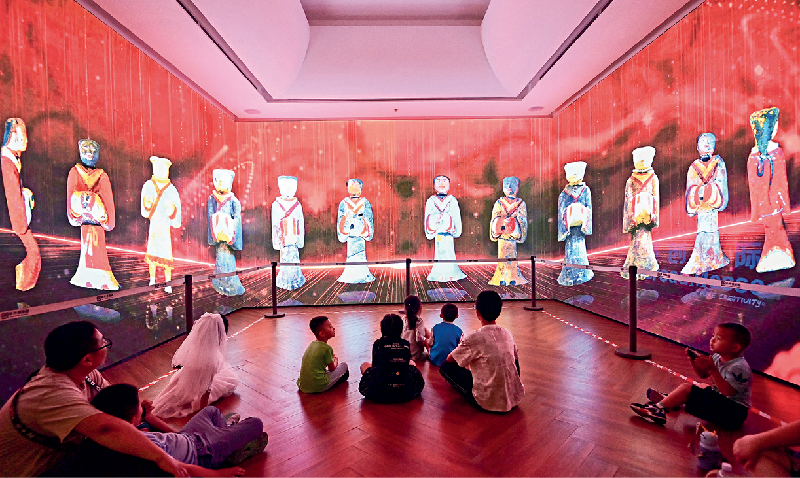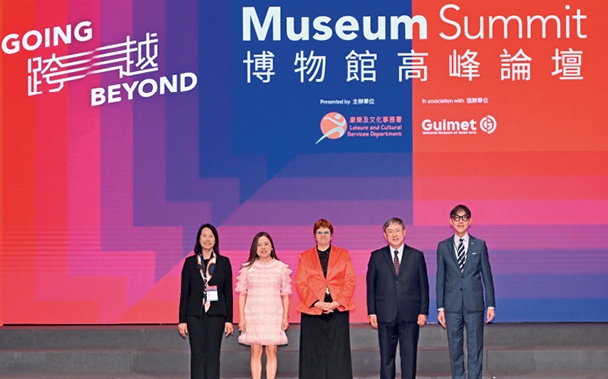May 18, 2025 marked the 49th International Museum Day. According to the National Cultural Heritage Administration, by the end of 2024, there were 7,046 registered museums in China, an increase of 213 from the previous year. Museums across the country received 1.49 billion visits throughout the year.
The Museum Summit 2025, themed "Going Beyond,” was held at the Hong Kong Convention and Exhibition Centre on March 28. Over 30 cultural heritage experts and professionals from 17 countries discussed the development directions of museums at thematic sessions, namely “Museums + Tourism,” “Museums + Technology,” “Museums + Sustainability,” and “Museums + Wellness,” opening a new chapter in establishing, resuming, and deepening cooperative relationships within the global museum and cultural heritage sectors.

Children learn about cultural relics through a presentation shown on electronic screens at the Qingzhou Museum in Shandong Province on June 14, 2025.
Opportunities and Challenges
In the context of the integration of culture and tourism, the role of museums in promoting tourism has become increasingly significant. Thus, “traveling to visit museums” has emerged as a new leisure trend and consumption fad.
Museums play a vital role in promoting tourism, preserving historical culture, and expanding education, helping people gain a deeper understanding of cultural heritage from various regions, said Fayrouz Fekry, deputy director for management and operation of the National Museum of Egyptian Civilization. Moreover, the activities provided by museums, such as engaging and educational interactive experiences, attract visitors and researchers, and facilitate academic exchanges.
Although the integration of museums with cultural and tourism sectors has become a trend, there are still areas that need further practical tweaks. Eike Schmidt, director of Museo e Real Bosco di Capodimonte in Naples, Italy, pointed out that the current issues of both overtourism and insufficient tourism are also causing difficulties for museum development.
To address insufficient tourism, the Museo e Real Bosco di Capodimonte is actively implementing a variety of measures, including reorganizing exhibition spaces, using innovative communication and educational strategies, introducing digital technology, and designing more accessible and inclusive exhibition routes, allowing the public to more conveniently engage with and appreciate artworks.
The Uffizi Galleries of Italy has launched an initiative to spread the riches of its collection in locations around different parts of Tuscany. This initiative not only reduces the burden on the main gallery but also stimulates new development opportunities for small towns and lesser-known museums.
Museums are a critical pillar of the cultural tourism industry. The immersive experiences both educate and inspire visitors. With the continuous tourism development, museums must be bold to innovate and commit to sustainable development, in order to maintain their appeal to new generations. In the future, museums can better leverage their cultural value and tourism function by deeply exploring the value of cultural relics, expanding cultural offerings, and innovating services, thus making a greater contribution to the high-quality development of the integration of culture and tourism.
Sci-Tech Innovation
Today, the rapid development of technology is profoundly impacting all aspects of society. How to leverage technology to innovate exhibition styles and provide visitors with more trendy and diverse learning opportunities has become a challenge in topic for museums worldwide.
Didier Fusillier, president of French government body Réunion des musées nationaux-Grand Palais, proposed that advancements in technology are redefining museums and cultural institutions, as witnessed by the rise of a hybrid space. This space blurs the boundaries between art, technology, and innovation. The new-era museums thus create the need to adopt a mixed mode, guiding audiences to engage deeply by showcasing works that combine artificial intelligence (AI), generative art, virtual reality, and dynamic tracking technologies. This allows visitors to appreciate the beauty of art as well as understand the thoughts and processes behind artistic creation.
Miraikan from the National Museum of Emerging Science and Innovation in Japan, presents cutting-edge science and technology to its audience, sparking their exploration of the future. The museum integrates robotics and AI into its exhibition space to showcase how these technologies enhance the visitor experience and inspire discussions about future society.
Additionally, the museum hosts a variety of scientific activities covering significant areas such as global environments, space exploration, life sciences, AI, and computing. Through collaborations with universities and research institutions, the museum tests and promotes advanced technologies, providing visitors with the opportunities to experience the latest innovations.
Many museums are exploring ways to achieve diversified integration and innovative practices. Li Mengdi, chairman of Silkroad Visual Technology Co., Ltd., said that the company is assisting museums in participating in urban development. Through public art installations, digital blocks, and flash mob, the narratives of museums are being integrated into the urban fabric, allowing culture to permeate daily life and connect the public with history and the future.

The Museum Summit 2025 kicks off at the Hong Kong Convention and Exhibition Centre on March 28, bringing together over 30 leading professionals from world-renowned museums and institutions worldwide to share expertise, research, and innovative ideas.
Sustainable Development
At this summit, the Guimet Museum in Paris (French National Museum of Asian Arts), presented the Guimet+ program. Aiming to establish lasting and close connections with local cultures, education sectors, social structures, and communities, the museum plans to showcase its collection in multiple cities, with each location hosting an exhibition for four years. Through immersive experiences involving visual, auditory, olfactory, and interactive elements, audiences will explore various Asian cultures, including those of China, Japan, India, and the Himalayan region.
According to Anne Yanover, the museum’s director of programming and audience engagement, Guimet adheres to environmentally friendly principles in its exhibitions, choosing a flexible design that can be adjusted and reused according to the actual environment of the exhibition content and location each year.
Xu Xiaoting, director of the Suzhou Museum, also shared her views on museums’ green, inclusive, and innovative development. Museums need to consider how to provide more equitable high-quality education, allowing everyone to have the opportunity for lifelong learning. This includes how to collaborate across sectors with other social forces to achieve museum transformation and redefinition, realizing the healthy and sustainable development of museums. As a result, this will bring about a new round of reform and innovation, and provide feasible and creative solutions to the current challenges in society, economy, and environment.
People Centered
When exploring the role of museums, one of their most important functions is to promote positive human interactions, enhance people’s cultural confidence, and alleviate negative sentiments.
The Stuttgart State Gallery in Germany has long adhered to the principle of inclusivity and being committed to facilitating individuals with physical and mental disabilities. From 2023, it has collaborated with local hospitals to introduce guided tours and lecture programs for patients, attempting to leverage the power of art to improve the physical and mental health of those in need.
The Queensland Art Gallery | Gallery of Modern Art in Australia, actively sought solutions during the COVID-19 pandemic when faced with the predicament of having to close. They strengthened their online platform and launched new online painting workshops and other activities. After the gallery reopened, the staff continued to dedicate themselves to promoting mental and physical well-being, including designing activities for students and educators, organizing workshops to assist individuals with cognitive impairments, and establishing learning centers that cater to the needs of diverse groups. These efforts have all yielded encouraging results.
The Turin City Museum of Ancient Art invites visitors to delve into a tranquil atmosphere, allowing them to fully appreciate the exquisitely crafted artworks, thereby fostering positive thinking. Through human-centered services and targeted creativity, museums around the world are assisting visitors in improving physical and mental well-being.
During recent years, museums in Hong Kong have been evolving rapidly. In addition to the renowned museums such as Hong Kong Palace Museum and Hong Kong Museum of Art, smaller, unique museums have also gained recognition. They not only showcase the long history, diverse culture, and splendid development of Hong Kong to tens of thousands of visitors but also narrate the captivating stories in their own distinct ways.
The two-day summit served as an important platform for communication, mutual learning, experience sharing, and exploration of innovation within the global museum community. This year, over 1,000 guests from around the world gathered at the summit in Hong Kong, enthusiastically participating in various activities.
At the closing ceremony, the Director of the Hong Kong Leisure and Cultural Services Department, Chan Wing-man, stated that the summit, now in its fourth edition, is striving to reshape and transcend traditional boundaries, just like museums and society in general. The expansion of the role of museums reflects their power as agents of change, connecting humanity with culture. Museums are no longer merely symbols of the past; they have become an indispensable part of the cultural life of cities. 
SHEN XIAONING is vice president of Peace Book Co., Ltd.